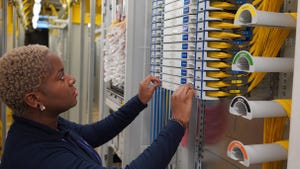Subsea Market Bubbles
There are signs the subsea bandwidth market is improving, operators say prices may be stabilizing
October 25, 2005

Changes are bubbling under the surface in the submarine cable market as there are signs the transatlantic market in particular is starting to improve.
Operators say that in the last six to nine months there's been a noticeable slowdown in the rate at which prices are falling on the transatlantic route. "It may be too soon to say they've stabilized, but price erosion hasn't continued in the same pace as it used to," says Gerard Akkermans, who deals with strategic pricing in Europe for {dirlink 5|71} (Nasdaq: GLBC).
The fundamental problem has been a glut of overcapacity plaguing the market since the hyperactive investment of the bubble days, so that even though demand for capacity has risen steadily with the growth of the Internet, prices have continued to fall.
Now, several factors are converging to shift the market, starting with the fact that an endless fall in prices, at a rate of around 40 percent a year, simply isn't sustainable. "There have been such significant decreases in the last three, four, five years that there has to be some inflection point," says Al DiGabriele, director of global pricing at Global Crossing.
Second, the TAT-14 Cable System, with a dual-route capacity of 640 Gbit/s, is reaching maximum capacity, and the major international telcos are looking at where to go next. There have been rumors that a consortium of carriers is looking to bulk-buy capacity to call the bottom on pricing, but also because they need the extra bandwidth. (See Undersea Market Resurfaces.)
"The larger carriers are ordering 10-Gbit/s or multiples of 10-Gbit/s capacity to meet the demand of the broadband market," says Chris Wood, VP of marketing at {dirlink 5|63} (OTC: FLHLQ). FLAG has said that during the first half of 2005, it saw a dramatic surge in demand for wavelength across the Atlantic, with orders rising by 500 percent. (See Flag Sees 500% Surge .) "Prices here are still very competitive, but for high-quality connectivity the rate of fall has slowed, and is now stabilizing," says Wood.
Global Crossing has also seen demand shift from lower capacity connections to larger pipes, say Akkermans and DeGabriele -- whereas before customers would order DS and STM connections, they now require STM-16s and wavelength services.
One of the most important developments is the arrival of the 20,000 kilometer SE-ME-WE-4 cable, which will connect Southeast Asia, the Middle East, and Western Europe. The cable was commissioned to run from Singapore to Marseilles, France, and is having a knock-on effect for the transatlantic market. Alan Robinson, managing director of the Apollo cable -- a joint venture between {dirlink 5|254} (NYSE: CWP) and {dirlink 2|9} (NYSE: ALA; Paris: CGEP:PA) -- says the operator is already starting to see requirements from the major players to carry traffic coming into Marseilles from Asia across to New York.
Asia's telecom markets are seeing tremendous growth in demand for bandwidth, both for consumer Internet use and corporate data networks. "In the last year we've seen much more requests for capacity into India," says Akkermans, noting that the shift is partly due to outsourcing and companies needing connections to offices there. Illustrating his point, last week {dirlink 2|19} (Nasdaq: CSCO) announced a substantial investment in the country, where it's raking in business for its networking equipment. (See Cisco Pays to Play in India and Cisco Invests $50M.)
In fact, the Asian subsea market offers the first hint of pricing stabilization, according to FLAG. In contrast to the glut across the Atlantic, areas such as India, the Middle East, and Africa, all emerging markets, remain underserved by submarine cable, and there are a number of building projects going on. To cite just a few examples: FLAG has recently completed a landing point in Mumbai for the Falcon cable connecting Asia with Europe; Videsh Sanchar Nigam Ltd. (VSNL) (NYSE: VSL) and Bharti Tele-Ventures Ltd. have said they'll invest $40 million each to launch Indian landing stations for SE-ME-WE-4; and Sri Lanka Telecom is teaming with India's Bharat Sanchar Nigam Ltd. (BSNL) to build a $15 million cable linking the two countries.
In Asia, there's a benefit to learning from the mistakes made on the transatlantic route. "The market realizes that 'free is not an economic model,' and if you price below cost, you will not survive," says Wood from FLAG Telecom. Since pricing outside the Atlantic is still higher, it's more profitable for operators -- so they can afford to invest in building projects.
In that sense, there's an "interesting crunch point coming up" for the transatlantic market, says Apollo's Robinson. "There’s still a long way to go to see costs being covered," and yet, looking ahead, if demand for capacity continues on the up, cable operators will have to make more available, which means shelling out to buy new equipment. There might be oversupply on the route, but only about 20 to 25 percent of the total available capacity is lit. "It has just got to be lit, and there's got to be investment to light it," he says. "Whether that will be in 2007 or 2008 is arguable, but it's going to happen in the next few years."
The operators agree that, although it's unlikely prices will rise in the near future, if they don't, there won't be enough money to cover costs and finance capacity upgrades. TeleGeography Inc. analyst Jason Kowal says Apollo may stand to benefit the most from a purchase of capacity. "Through some good decisions made a few years ago, Apollo has the greatest tranche of available lit capacity," says Robinson. That puts it in a good position "in terms of who has to blink last."
What's prolonging the agony is that both the carriers and cable operators are going for the easy alternatives, deploying cheap equipment and looking for ways to maximize lit capacity.
"If you exclude TAT-14 as a cable that's reaching maximum capacity, there are still four major cable systems across the Atlantic," Robinson says. And FLAG's Wood notes that "DWDM technology allows existing cables to be upgraded to many times their original design capacity, simply by changing the electronics in the landing stations along the route." That approach is also more convenient, because operators can upgrade live cables one segment at a time as the need arises, with little disruption.
Last week, optical transport vendor Xtera Communications Inc. announced FLAG has purchased additional DWDM equipment in response to the surge in orders on the FLAG Atlantic-1 cable. (See Xtera Lands FLAG Deal.) Its Nu-Wave technology uses low-loss optical add/drop multiplexers to simplify the network while increasing its flexibility so that fewer network elements have to be serviced.
"I don’t want to sound pessimistic, but I can't say with 100 percent confidence that in a year we will see prices increasing," says Global Crossing's DeGabriele.
"To say it's turning around is being optimistic," concurs Robinson. The "jury is still out" on whether the market is entering a growth cycle, but at the same time, he says, "it's looking more positive than it has done for some years."
— Nicole Willing, Reporter, Light Reading
You May Also Like










